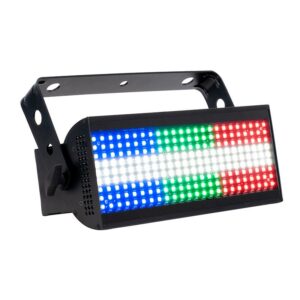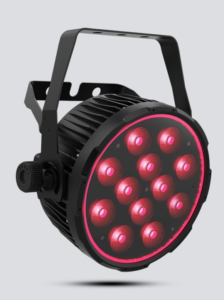So what is pixel mapping?
DJ lighting has been more or less the same for the last decade. Sure, LEDs have gotten brighter, and moving heads have gotten smaller. But plenty of DJs are still taking out their moonflowers and starfield lasers every week. There’s nothing inherently wrong with that, but no denying the event industry is changing. Clients are looking to upgrade their events and create a more polished atmosphere. Wedding planners are looking for DJs who can offer something new and fresh to their couples. One bit of technology has started to make its way into more DJ lights and is poised to be the next greatest trend in lighting – pixel mapping. In fact, we here at The DJs Guru think pixel mapping could be the future of DJ lighting.
Ever heard of pixel mapping?
Don’t feel too bad if you haven’t – it isn’t quite commonplace yet. DJs who work large productions or school dances may be more familiar with it. However, the average DJ has probably never looked too much into it. At the core, pixel mapping can control individual LEDs, or “pixels,” within a light fixture. Instead of changing the color or brightness of the entire light, users can change different zones to create eye-catching patterns and displays.
With most wash lighting, you select a color for all the LEDs in your light, and that’s it. Some lights may even offer 2 or 3 areas of color or brightness control. On the other hand, a pixel-mappable light allows programming down to the individual LED. With enough LEDs, you can create patterns, shapes, text, and even images. Pixel mapping doesn’t end with single lights. If you have more than one fixture capable of pixel mapping, you can display images and media across multiple lights as well!
Do I really need to pixel map?
“Hold up,” you say, “This seems like way more work than I want to do for a 150 person wedding.” And you know what, I’d be inclined to agree with you. But there’s good news – you don’t need complex media servers and extensive programming knowledge to take advantage of pixel mapping. Pixel-mappable lights for DJs, just like other lights, have their own built-in automatic programs. Even the most basic internal automatic mode will look leaps and bounds better than a simple wash fixture that changes color. The best part? You won’t be bombarding your guests with bright wash lights and laser beams. Instead, your pixel mappable lights will create attractive eye-candy that washed the dance floor without being excessive.
“So, am I going to need to learn a ton of DMX to get into this?” Not really. Even thinking of pixel mapping with an old-school hardware DMX controller was ludicrous for a long time. It would simply take too much time to slide the faders and twist the knobs for 50, 100, 150+ individual LEDs. Thankfully, software DMX programs like MyDMX and ShowXpress have become the norm in the mobile DJ industry. Now, programming pixel mapping effects is as simple as selecting an effect from the built-in software generator. The program will automatically create all of the DMX commands (literally hundreds or thousands) in a matter of seconds. Everything can be done visually on a screen without worrying about assigning channel values and step lengths. For DJs that want more in-depth control, there are plenty of more advanced control software options.
What about lights, what do you recommend?
So if this is all sounding good to you, you might be thinking of adding some pixel mappable lights to your arsenal. There are a handful of options available right now, but being able to but multiple might bring your budget down a little. Luckily, there are some great options out there for under $450. Here are our top 3 recommendations.
JMAZ PIXL FX BAR 5050
The PIXL FX BAR 5050 is the first and most affordable light on our list. Despite the low price, it packs a monstrous 96 RGB surface mount diodes (SMDs), 144 ultra-white SMDs, and 12 warm white beams (yeah, that’s over 250 individual LEDs). The mixture of different LED types allows for all kinds of unique effects. The RGB diodes can be used for your main color wash and pixel effects. The cool white SMDs can take the place of your strobe lights. And the warm white beams work perfectly for a blinder (or just as a great wash during the first dance at a wedding).
Behind all those diodes are up to 51 channels of DMX control. While you can’t control every single pixel on the light, 51 channels still offer plenty of flexibility in creating mesmerizing eye-candy effects. If you aren’t up for programming, there are many built-in macros to choose from.
ADJ Jolt 300
Another great option for first-time pixel mappers is the Jolt 300 from ADJ. Instead of a long bar like the JMAZ 5050, the Jolt 300 is more compact and punchy. Under the case are 144 white SMDs and 144 RGB diodes (again, we are talking about almost 300 individual LEDs). The bright white SMDs are lined up down the middle of the fixture and perfect for a bright strobe or blinder effect.
If you’re looking for a more simple light to operate with massive output, then the Jolt 300 is perfect. It offers up to 18 channels of control – not exactly single-pixel mappable, but zones of control that still allow for unique patterns and effects. It’s got a nice wide 120-degree beam angle for good dance floor coverage with fewer fixtures. 32 built-in programs mean lots of variety for those that choose to avoid DMX.
Chauvet DJ SlimPAR Pro Pix
Last on our list is a newcomer – the SlimPAR Pro Pix from Chauvet DJ. This light doesn’t quite look like the previous two – it’s a par instead of a bar. And it doesn’t go for shock and awe with hundreds of LEDs. Instead, 12 bright hex-color diodes in the center are surrounded by 57 smaller RGB diodes that form a lighted ring at the edge of the case. This effect is unique and, in my opinion, very eye-catching. At first glance, you might mistake it for a normal par wash light, which may not be a bad thing. This little light could easily blend in at more upscale events. The silent operation (no moving parts) aids in that process.
However, when it comes to party time, the combination of pixel-mappable center diodes and the outer light ring is sure to keep guests’ attention. If you’ve got a DMX controller or software program, you can take advantage of up to 48 channels of control. If you want to take the automatic route, you’ve got a handful of automated programs to choose from.
Is pixel mapping the future of DJ lighting?
We sure think so. Spinning moonflowers and laser beams may still have a place at certain events, but for DJs looking to elevate their image and offer something new, pixel mapping is an attractive option. These lights offer the flexibility of massive amounts of programming potential bundled with easy-to-use automated programs. They can create eye-catching effects without overwhelming the dance-floor and pissing off photographers. Ultimately, they are a fresh take on effect lighting that stands out from the tired fixtures we’ve all become used to.
So what’s your take – do you think pixel mapping is the future of DJ lighting? Do you use any pixel mappable lights? Let us know down in the comments! Need advice or a great deal? We can help with that too, fill out our “Deal portal” below, and we’ll get to work for you. Learn, grow, succeed, and great deals too!



